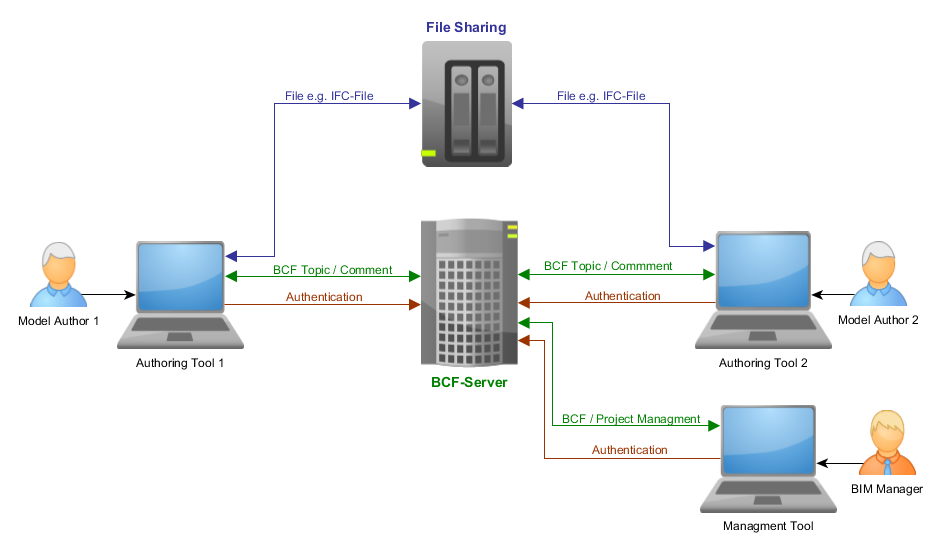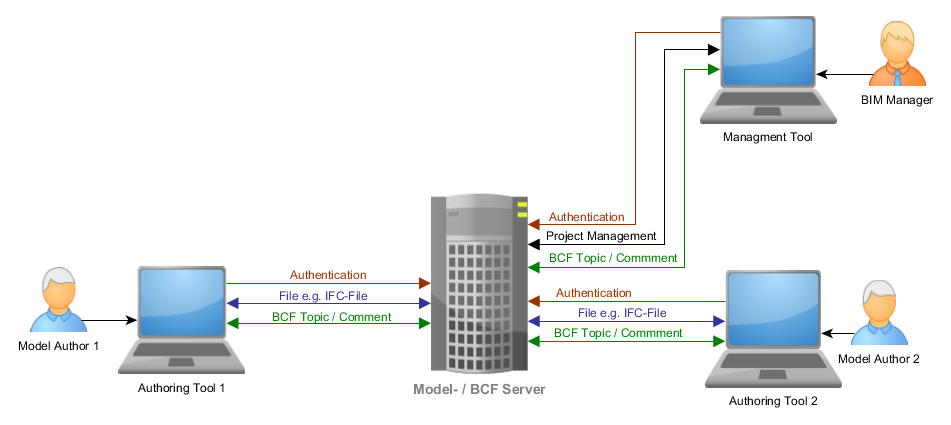Version 1.0 based on BCFv2. GitHub repository
BCF is a format for managing issues on a BIM project. RESTful BCF-API supports the exchange of BCFv2 issues between software applications.
All API access is over HTTPS. Data is sent as query parameters and received as JSON. Every resource has a corresponding Json Schema (Draft 03). Json Hyper Schema is used for link definition. Authentication method is OAuth2.
- Link header introduced by RFC 5988
- custom HTTP header X-Total-Count (HEAD)
page, page_size, sort
Only „descending“ if property exits.
If no descending property is there -> ascending=true
if descending=true -> descending
if descending=false -> ascending
"&" to combine different query parameters (operations)
Example 1:
.../bcf/{version}/projects/{guid}/topics?page=1&page_size=5&sort=priority&descending=true
Example 2:
.../bcf/{version}/projects/{guid}/topics?page=1&page_size=5&sort=priority&descending=true&filter=(label%3DArchitecture%7Clabel%3DStructural)%26topicstatus%21%3DClosed
ETags, or entity-tags, are an important part of HTTP, being a critical part of caching, and also used in "conditional" requests. The ETag response-header field value, an entity tag, provides for an "opaque" cache validator. The easiest way to think of an etag is as an MD5 or SHA1 hash of all the bytes in a representation. If just one byte in the representation changes, the etag will change.
ETags are returned in a response to a GET:
joe@joe-laptop:~$ curl --include http://bitworking.org/news/
HTTP/1.1 200 Ok
Date: Wed, 21 Mar 2007 15:06:15 GMT
Server: Apache
etag: "078de59b16c27119c670e63fa53e5b51"
Content-Length: 23081
…..
The server will put the "Access-Control-Allow-Headers" in the response header and specify who can access the server(json) resources. The client can look for this value and proceed with accessing the resources.
The server has a web config file .. "*" means the server allow the resources for all domains.
<httpProtocol>
<customHeaders>
<add name="Access-Control-Allow-Headers" value="Content-Type, Accept, X-Requested-With, Authorization" />
<add name="Access-Control-Allow-Methods" value="GET, POST, PUT, DELETE, OPTIONS" />
<add name="Access-Control-Allow-Origin" value="*" />
</customHeaders>
</httpProtocol>
- 200 OK (Data is returned)
- 201 No content (Data has been deleted)
- 302 Redirect (Returning a redirect to the GET-resource for the data that has been created/updated)
- 400 BadRequest (Input data is invalid)
- 401 Unauthorized (User don’t have access to the requested resource)
- 403 Forbidden
- 404 Not found (It must be discussed if the user should get “unauthorized” to resources he don’t have access to, or “not found")
- 422 Unprocessable entity (Input data is well formed, but the semantic is wrong; Example: Resource define that a value cannot be “null”, but the value is “null”)
BCF-API has a specified error response body format error.json.
Model collaboration is managed through a shared file server or a network file sharing service like Dropbox. The BCF-Server handels the Authentication and the BCF-Issues.
BCF and model server are co located on the same hosts.
Recource URL (public resource)
GET /bcf/version
Parameters
| version_id | string | ID of the version |
| detailed_version | string | URL to version on Github |
| link_schemas | string | URL to schemas on Github |
Authentication is based on the OAuth 2.0 Protocol.
Recource URL (public resource)
GET /bcf/auth
Parameters
| oauth2_auth_url | string | URL to authorisation page |
| oauth2_token_url | string | URL for token requests |
Example Request
https://.../bcf/auth
Example Response
{
"oauth2_auth_url": "https://bim--it.net/bcf/oauth2/auth",
"oauth2_token_url": "https://bim--it.net/bcf/oauth2/token"
}
Oauth2 protocol flow - Client Request -
The Client uses the "oauth2_auth_url" and adds the following parameters to it.
- response_type -> code
- client_id -> your client_id
- state -> unique user defined value
Example Url:
https://bim--it.net/bcf/oauth2/auth?response_type=code&client_id=<YourClientID>&state=D98F9B4F-5B0E-4948-B8B5-59F4FE23B8E0
Tip: You can use the state parameter to transport custom information.
Open a browser window or redirect the user to this resource. This redirects back to the specified redirect URI with the provided state and the authorization code as a query parameter if the user allows your app to access the account, the value "access_denied" in the error query parameter if the user denies access.
Oauth2 protocol flow - Token Request -
The Client uses the "oauth2_token_url" to request a token.
POST https://bim--it.net/bcf/oauth2/token
Content type: application/x-www-form-urlencoded.
The POST request has to be done via HTTP Basic Authorization. Your "ClientID" is the username, your "ClientSecret" is the password.
Post Request Body:
grant_type=authorization_code&code=<YourAccessCode>
The access token will be returned as JSON in the response body and is an arbitrary string, guarantied to fit in a varchar(255) field.
Oauth2 protocol flow - Refresh Token Request -
The process to retrieve a refresh token is exactly the same as retrieving a token except the Post Request Body.
Post Request Body:
grant_type=refresh_token&refresh_token=<YourRefreshToken>
The refresh token can only be used once to retrieve a token and a new refresh token.
Oauth2 protocol flow - Requesting Resources -
When requesting other resources the access token must be passed via the Authorization header using the Bearer scheme (e.g. Authorization: Bearer T9UNRV4sC9vr7ga).
Recource URL
GET /bcf/{version}/projects
Retrieve a list of projects where the currently logged on user is assigned to.
Example Request
https://.../bcf/1.0/projects
Example Response
[{
"project_id": "F445F4F2-4D02-4B2A-B612-5E456BEF9137",
"name": "Example project 1"
},
{
"project_id": "A233FBB2-3A3B-EFF4-C123-DE22ABC8414",
"name": "Example project 2"
}]
Recource URL
POST /bcf/{version}/projects
Add a new project
Parameters
JSON encoded body using the "application/x-www-form-urlencoded" content type.
| name | string | The project name |
Example Request
https://.../bcf/1.0/projects
{
"name": "Example project 3"
}
Example Response
{
"project_id": "B724AAC3-5B2A-234A-D143-AE33CC18414"
"name": "Example project 3",
}
Recource URL
GET /bcf/{version}/projects/{project_id}
Retrieve a specific project
Example Request
https://.../bcf/1.0/projects/dabc6dfce6e849bfada976d9fa9e294a
GET, PUT, DELETE /bcf/{version}/projects/{project_id}
-
GET - Retrieve a specific project
-
PUT - Modify a specific project
-
DELETE - Delete a specific project
GET, POST, PUT, DELETE /bcf/{version}/projects/{project_id}/extension
-
GET - Retrieve the project extension schema
-
POST - Add the project extension schema
-
PUT - Change the project extension schema
-
DELETE – Delete the project extension schema
Long URL: -
GET, POST /bcf/{version}/projects/{project_id}/topics
- GET - Retrieve topics of a project (default sort = CreationDate)
- POST - Add a new topic to a project
Long URL: -
GET, PUT, DELETE /bcf/{version}/topics/{guid}
- GET - Retrieve a specific topic
- PUT - Update a specific topic
- DELETE - Delete a specific topic
Long URL: /bcf/{version}/projects/{project_id}/topics/{guid}
GET /bcf/{version}/topics/{guid}/files
- GET - Retrieve the header of a topic
- POST - Assign a file to a topic
Long URL: /{version}/projects/{project_id}/topics/{guid}/files
DELETE /bcf/{version}/topic/{guid}/files/{reference}
- DELETE - Remove a file from topic header
Long URL: /bcf/{version}/projects/{project_id}/topics/{guid}/revisions/{reference}
GET, POST /bcf/{version}/topics/{guid}/comments
- GET - Retrieve comments of a topic
- POST - Add a new comment to a topic
Long URL: /bcf/{version}/projects/{project_id}/topics/{guid}/comments
GET, PUT, DELETE /bcf/{version}/comments/{guid}
- GET - Retrieve a specific comment
- PUT - Update a specific comment
- DELETE - Delete a specific comment
Long URL: /bcf/{version}/projects/{project_id}/topics/{guid}/comments/{guid}
GET, POST, DELETE /bcf/{version}/comments/{guid}/viewpoint
- GET - Retrieve the viewpoint assigned to a comment
- POST - Assign a viewpoint to a comment
- DELETE - Delete the viewpoint assigned to a comment
Long URL: /bcf/{version}/projects/{project_id}/topics/{guid}/comments/{guid}/viewpoint
GET, POST, DELETE /bcf/{version}/comments/{guid}/reply_to
- GET - Retrieve the replyTo comment related to a comment
- POST - Add a replyTo comment relation to a comment
- DELETE - Delete the replyTo comment relation on a comment
Long URL: /bcf/{version}/projects/{project_id}/topics/{guid}/comments/{guid}/reply_to
GET, POST /{version}/topics/{guid}/viewpoints
- GET - Retrieve viewpoints of a topic
- POST - Add a new viewpoint to a topic
Long URL: /{version}/projects/{project_id}/topics/{guid}/viewpoints
GET, PUT, DELETE /{version}/viewpoints/{guid}
- GET - Retrieve a specific viewpoint
- PUT - Modify a specific viewpoint
- DELETE – Delete a specific viewpoint
Long URL: /{version}/projects/{project_id}/topics/{guid}/viewpoints/{guid}
GET, POST, DELETE /{version}/viewpoints/{guid}/bitmap
- GET - Retrieve the bitmap related to a viewpoint
- PUT - Add a bitmap to the viewpoint
- DELETE – Delete the bitmap of the viewpoint
Long URL: /{version}/projects/{project_id}/topics/{guid}/viewpoints/{guid}/bitmap
GET, POST /{version}/viewpoints/{guid}/components
- GET - Retrieve components of a viewpoint
- POST - Add a new component to a viewpoint
Long URL: /{version}/projects/{project_id}/topics/{guid}/viewpoints/{guid}/components
GET, PUT, DELETE /{version}/components/{ifc_guid}
- GET - Retrieve a specific component
- PUT - Modify a specific component
- DELETE – Delete a specific component
Long URL: /{version}/projects/{project_id}/topics/{guid}/viewpoints/{guid}/components/{ifc_guid}
GET, POST /{version}/topics/{guid}/related_topics
- GET - Retrieve related topics to a topic
- POST - Add a new related_topic to a topic
Long URL: /{version}/projects/{project_id}/topics/{guid}/related_topics
DELETE /{version}/topics/{guid}/related_topics/{guid}
- DELETE – Delete related topic
Long URL: /{version}/projects/{project_id}/topics/{guid}/related_topics/{guid}
GET, POST /{version}/topics/{guid}/document_references
- GET - Retrieve documents referenced on a topic
- POST - Add a new document reference to a topic
Long URL: /{version}/projects/{project_id}/topics/{guid}/document_references
DELETE /{version}/topics/{guid}/document_references/{guid}
- GET - Retrieve a document referenced on a topic
- DELETE – Delete a document reference
Long URL: /{version}/projects/{project_id}/topics/{guid}/document_references/{guid}

